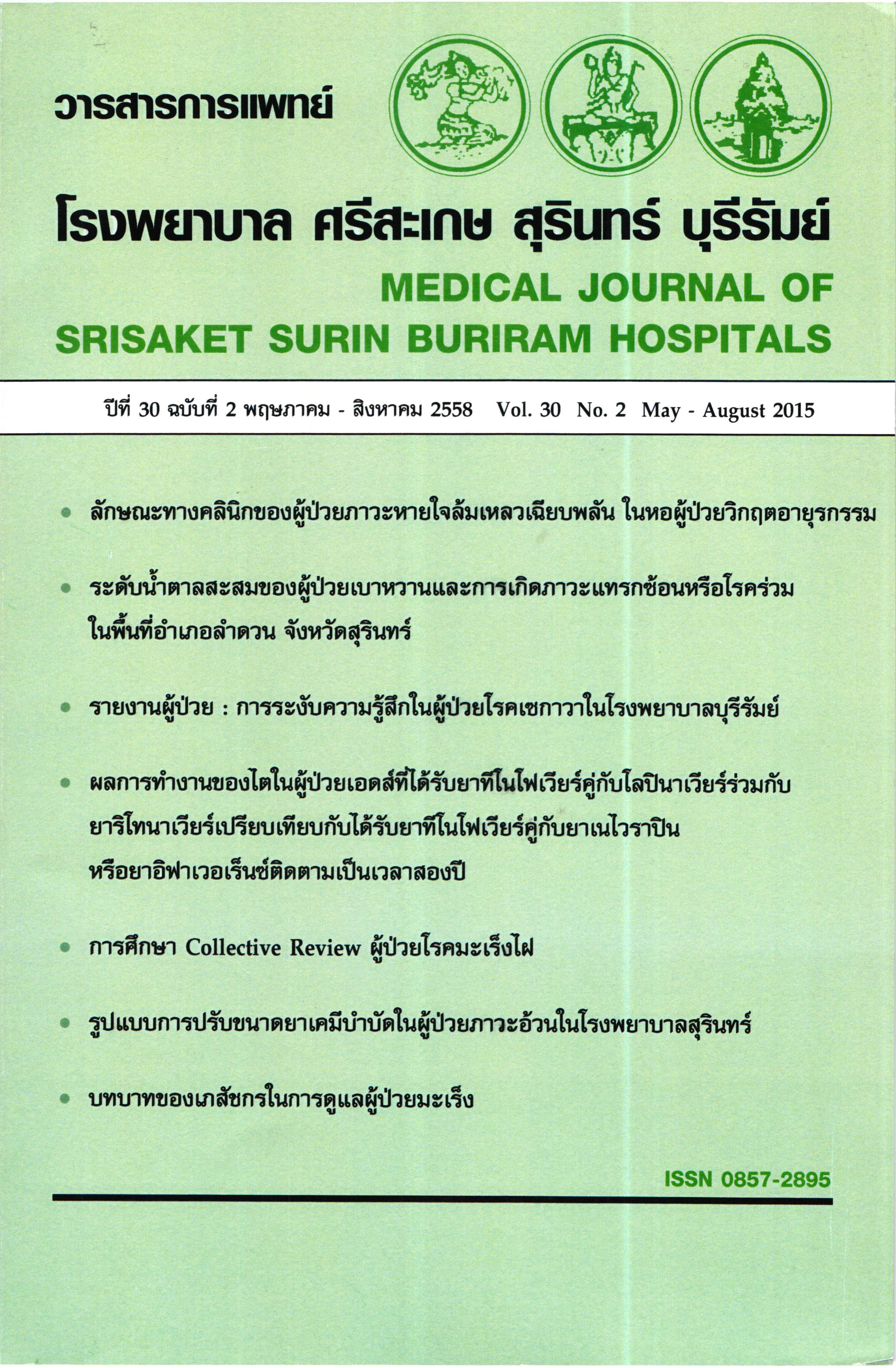รายงานผู้ป่วย: การระงับความรู้สึกในผู้ป่วยโรคเซกาวาในโรงพยาบาลบุรีรัมย์
Main Article Content
บทคัดย่อ
โรคเซกาวา (Segawa’s disease) เป็นโรคถ่ายทอดทางพันธุกรรม ที่พบได้ยาก มีอาการกล้ามเนื้อเกร็ง และอ่อนแรง (Dystonia) ทีเปลี่ยนแปลงในแต่ละช่วงวัน (Diurnal variation) และมีการตอบสนองที่ดีมาก ต่อการรักษาด้วยยา Levodopa เนื่องด้วยเป็นโรคที่พบไม่บ่อย ทำให้ขาดแคลนข้อมูลและองค์ความรู้ในการ ระงับความรู้สึกแก่ผู้ป่วยในกลุ่มโรคนี้
ผู้รายงานนำเสนอประสบการณ์ในการให้การระงับความรู้สึกแก่ผู้ป่วย Segawa’s disease 3 ครั้งใน ผู้ป่วยรายเดียวกัน โดยผู้ป่วยได้รับการรักษาด้วยยา Levodopa ตลอดจนกระทั่งวันผ่าตัด การผ่าตัดครั้งแรก ให้การระงับความรู้สึกด้วยวิธีให้ยาระงับความรู้สึกทางหลอดเลือดดำ (Total IV Anesthetic care) ในการ ผ่าตัดขูดมดลูก และ การให้ยาระงับความรู้สึกแบบทั่วไป (General anesthesia) ในการผ่าตัดคลอดอีก 2 ครั้ง โดยไม่พบภาวะแทรกซ้อนระหว่างและหลังผ่าตัดใดๆ
Article Details
รูปแบบการอ้างอิง
ฉันทะกุล ส., & ยิ้มรัตนบวร พ. (2018). รายงานผู้ป่วย: การระงับความรู้สึกในผู้ป่วยโรคเซกาวาในโรงพยาบาลบุรีรัมย์. วารสารการแพทย์โรงพยาบาลศรีสะเกษ สุรินทร์ บุรีรัมย์, 30(2), 91–94. สืบค้น จาก https://he02.tci-thaijo.org/index.php/MJSSBH/article/view/120346
ประเภทบทความ
รายงานผู้ป่วย
เอกสารอ้างอิง
1. Segawa M. Autosomal dominant GTP cyclohydrolase I (AD GCH 1) deficiency (Segawa disease, dystonia 5; DYT 5). Chang Gung Med J 2009;32:1:1-11.
2. PriscuV, Lurie S, Savir I, Rabinerson D, Hagay Z. The Choice of Anesthesia in Segawa's Syndrome. Journal of Clinical Anesthesia 1998;10:2:153-5.
3. Sinha A, Hartsilver EL. Anesthesia for caesarean section in a patient with dopa-responsive dystonia or Segawa's Syndrome. International Journal of Obstetric Anesthesia 2009; 18:1:67-72.
4. Yam CF, Ho ST, Ho YF. A case of a medically correctable pes cavus deformity-Segawa disease. Hong Kong Journal of Orthopaedic Surgery 2001;5:2:129-32.
5. Nutt JG, Fellman JH. Pharmacokinetics of levodopa. Clin Neuropharmacol 1984;7:l:35-49.
6. Senard JM, Verwaerde P, Rascol O, Montastruc JL. Effects of acute levodopa administration on blood pressure and heart variability in never treated parkinsonians. Hypertens Res 1995;18:Suppl 1:5175-7
7. Culley Deborah J, Brooks Meredith R, Crosby Gregory. Neurologic Disease and Anesthesia. In: Cottrell Jame E, Young William L, edited. Cottrell and Young's Neuroanesthesia 5th.ed. Philadelphia : Mosby Elsevier, 2010:390-9.
2. PriscuV, Lurie S, Savir I, Rabinerson D, Hagay Z. The Choice of Anesthesia in Segawa's Syndrome. Journal of Clinical Anesthesia 1998;10:2:153-5.
3. Sinha A, Hartsilver EL. Anesthesia for caesarean section in a patient with dopa-responsive dystonia or Segawa's Syndrome. International Journal of Obstetric Anesthesia 2009; 18:1:67-72.
4. Yam CF, Ho ST, Ho YF. A case of a medically correctable pes cavus deformity-Segawa disease. Hong Kong Journal of Orthopaedic Surgery 2001;5:2:129-32.
5. Nutt JG, Fellman JH. Pharmacokinetics of levodopa. Clin Neuropharmacol 1984;7:l:35-49.
6. Senard JM, Verwaerde P, Rascol O, Montastruc JL. Effects of acute levodopa administration on blood pressure and heart variability in never treated parkinsonians. Hypertens Res 1995;18:Suppl 1:5175-7
7. Culley Deborah J, Brooks Meredith R, Crosby Gregory. Neurologic Disease and Anesthesia. In: Cottrell Jame E, Young William L, edited. Cottrell and Young's Neuroanesthesia 5th.ed. Philadelphia : Mosby Elsevier, 2010:390-9.


